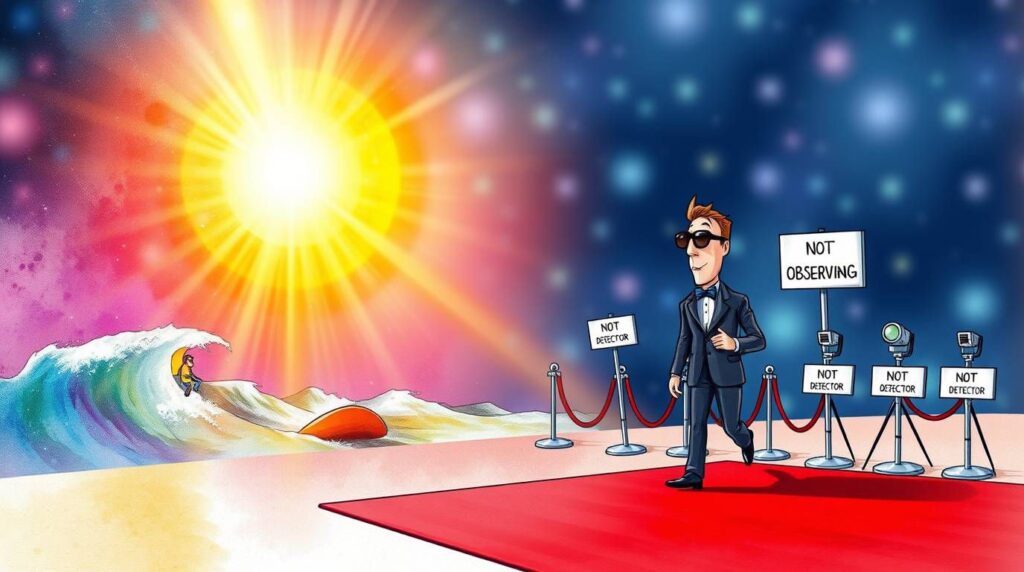What causes wave-particle duality in photons?
Awesome — so you’re here, which means you probably already know that light is kinda weird. And you’re not wrong. In fact, light (especially photons) is so weird that it can’t decide whether it wants to behave like a wave 🌊 or a particle ⚛️. And that’s what wave-particle duality is all about.
Let’s ditch the textbook talk and explain this in chill, friend-to-friend terms.
What Causes Wave-Particle Duality in Photons?
Alright. So imagine light is this super flexible person at a party — sometimes they groove like a wave, other times they bump into people like a ping-pong ball.
That’s not just light being dramatic. It’s actually baked into the laws of quantum physics.
Wave-particle duality means that photons (aka, tiny packets of light) can behave like:
- Waves — spreading out, interfering, creating patterns
- Particles — showing up in single spots, like little punches of energy
But here’s the real kicker: it’s not that photons are half wave and half particle. It’s that they act like one or the other depending on how you observe them. Yep — just the act of observing can change what they seem to be doing. Crazy, right?
So let’s break down what causes this trippy dual behavior.




☄️ 1. Photons Are Quantum Particles
Photons aren’t little marbles flying through space. They’re quantum objects — and in the quantum world, things don’t behave like regular objects.
Instead of having fixed positions or paths, quantum particles are described by probability — like, “Here’s a 70% chance the photon is here, and 30% it’s over there.”
This probability spreads out like a wave — that’s called a wavefunction. It’s not a wave made of stuff, but a math wave that predicts behavior.
So when you don’t measure the photon directly, it behaves like a wave of possibility. But once you try to pin it down, BOOM — it “collapses” into a particle at a single point.
—
🎥 2. The Double-Slit Experiment (aka: Light’s Weirdest Audition)
Okay, this experiment is iconic. Here’s what happens:
- You shine photons at a screen with two slits.
- If no one’s watching (no detector), the photons go all-out wave mode and create an interference pattern — like ripples on a pond overlapping.
- But if you try to observe which slit the photon goes through (you little spy), the photon’s like, “Oh? You watching me?” and suddenly behaves like a particle — no more wave interference.
Basically:
🕶️ No observation = wavy photon
👀 Observation = particle photon
The photon adjusts its behavior depending on whether it’s being watched. No joke.
—
🌀 3. It’s Not Just a Light Thing — It’s a Quantum Thing
Wave-particle duality isn’t only about photons. Electrons, neutrons, even some atoms show it too. But photons are the most famous for it because light is easy to study.
Why does this happen? Because quantum objects don’t “exist” in just one form. They exist in superpositions — multiple states at once — until something forces them to choose.
In other words:
A photon doesn’t “know” what it is until we interact with it. Then it picks a side — wave or particle — based on the situation.
It’s like a secret agent with two disguises and only reveals which one they’re wearing when you try to catch them in the act.
—
🔮 4. So… What Actually Causes the Duality?
The honest answer?
We don’t 100% know. 😅
It’s just the way nature works at the quantum level. What we do know is:
- Light has properties of both waves (like diffraction, interference) and particles (like photoelectric effect, energy quanta).
- Which behavior it shows depends on how we test it.
- This isn’t a flaw — it’s a built-in rule of how quantum systems work.
It’s not that light “decides” how to act — it’s that reality at the smallest scale is fundamentally different from what we experience.
So instead of asking “Why can’t it just be one or the other?”
The better question is:
“How wild is it that we live in a universe where things can be both?”
—
🧠 TL;DR — The Short Version:
- Photons are quantum particles — they follow rules that allow them to act like waves and particles.
- If you don’t look closely, they behave like waves.
- If you try to detect or measure them directly, they snap into particle mode.
- This duality is not confusion — it’s quantum magic.
- Reality is weirder than we thought.
—
📌 Disclaimer:
This easy version is meant to help you understand the concept better. If your exam or teacher expects a textbook explanation and you write this one instead, we’re not responsible if it affects your marks. Use this for understanding, not copy-pasting.
—
🔗 Related Articles from EdgyThoughts.com:
What If Reality Is a Simulation Running on Light 2025
https://edgythoughts.com/what-if-reality-is-a-simulation-running-on-light-2025
How Quantum Numbers Secretly Control Electrons 2025
https://edgythoughts.com/how-quantum-numbers-secretly-control-electrons-2025
🌐 External Resource:
Feeling curious about wave-particle duality in full detail? Here’s the Wikipedia page:
https://en.wikipedia.org/wiki/Wave–particle_duality
How can I manage exam stress effectively?
https://edgythoughts.com/how-can-i-manage-exam-stress-effectively/
How does working memory differ from short-term memory?
https://edgythoughts.com/how-does-working-memory-differ-from-short-term-memory/






One Comment